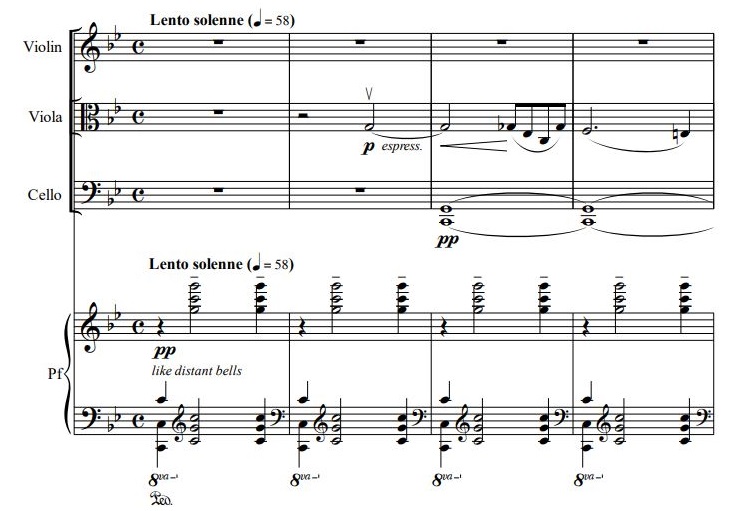Tonal Structure of the Piano Quartet
My Piano Quartet, composed in 1993 but revised in 2018-2019, was recorded in February 2020 by violinist Cari Sue Jackson, violist Camille Phillips, cellist Sarah Langford, and myself on the piano. The video shown at this end of this post presents that recording along with the score. The work consists of a single large movement in sonata-allegro form.

Its tonal structure resembles the tonal progression of a classical sonata, but with some Romantic twists. The piece’s tonic of B-flat major does not arrive until bar 23. The 22-bar introduction begins with C harmony, with the third initially omitted, creating a mysterious, primordial effect.

From C, there is a large-scale progression by descending fifths through F major to B-flat major, the latter coinciding with the beginning of the exposition proper at bar 23.

In a classical sonata, a progression from tonic to dominant would be expected within the exposition. In this quartet, the exposition includes three themes, progressing from B-flat major to G minor to D major.

Thus D major serves as a Romantic substitute for the expected dominant of F major. The dominant-substitute function of D major is conveyed by tone A, which is of course the leading tone in B-flat major, and that tone A is highlighted in the piece’s third theme.
The development is by far the longest section of the piece, and like most development sections it tonicizes various secondary tonal centers as it progresses. It also contains subsections suggesting incipient additional movements: a slow movement (b. 116), followed by a march (b. 177). A constant crescendo in tension leads to a dramatic climax at bar 323, coinciding with the arrival of dominant-seventh (F7) harmony. The tension and dynamic level then subside to a pianissimo at 335, marked Largo misterioso. A long dominant pedal point then begins, and a great crescendo leads to another great climax at b. 347, marked Grandioso, where the tonic returns and the recapitulation begins.
The first theme, which had been quiet and lyrical in the exposition, becomes majestic and dramatically powerful in the recapitulation. All three themes are now presented in the tonic (B-flat), just as in a typical classical sonata. (Theme 2 was originally in the minor mode, so naturally it is now in the parallel minor, B-flat minor.) A 39-bar coda then reinforces the tonic.
In a recent post, I explained the aesthetic goals that I was trying to accomplish in this Piano Quartet, as described in an essay I wrote at the time the work was composed. In particular, the essay discusses how unity and variety should be combined: I sought to achieve “a sense of unity across the whole composition, so that it can unite a variety of thematic or stylistic elements into a coherent whole.” That is accomplished in part by the tonal progression just described. But the device of thematic transformation also brings unity to the diversity of materials in this quartet, as I will discuss in a future post to this blog.
SCORE VIDEO:


